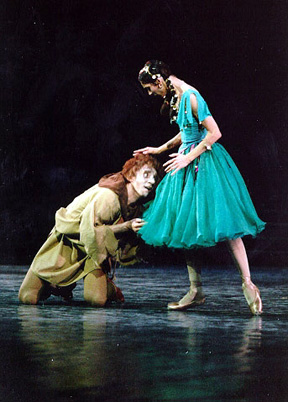Gypsies, Hunchbacks, and Tambourines
Esmeralda
New Jersey Ballet
New Jersey Performing Arts Center
Newark, New Jersey
April 22, 2004
by
Mary Cargill
copyright
© 2004 by Mary Cargill
published 26 April 2004

Esmeralda is the story of a poor dancer who falls in love above her station. Her beloved, the majestic Phoebus, is already engaged to a rich girl, who gets plenty of fouettés. Esmeralda in turn is lusted after by a priest, the Archdeacon Frollo, who offers to save her life if she will submit to him. Petipa, I suspect, saw no need to waste a good plot; what works in medieval France can also work in ancient India.
Unlike so many 19th century ballets, Esmeralda has no vision scene, though the wedding party in the second act provides an opportunity for a number of classical dances, including the current gala favorite, the Diana and Acteon pas de deux, along with what looks like a Petipa pas de quatre, with some wonderful pizzicato variations, danced with admirable precision by Gabriella Noa and Christine Theryoung.
The New Jersey Ballet has a number of Russian trained dancers, and they seemed to have an affinity for the drama. The Esmeralda, Julia Vorobyeva, was particularly effective in the prison scene and in her final farewell to life, where she danced broken pieces of her earlier, happier dances. (She has been condemned to death after being falsely accused of stabbing Phoebus—the duplicitous Frollo actually did it—but it is not clear why she has to die since Phoebus survived and was there to watch the hanging.)
Phoebus, in this version, is surely the most arrogant, smug, and unsympathetic of ballet’s decadent aristos; he doesn’t even get to repent his treatment of Esmeralda, but just walks off to wedded bliss with his rich fiancé. This is, I suppose, a more clear-eyed view of human behavior than the sufferings of Albrecht or Solor, but it does cut down on the dramatic possibilities of the role. Andrei Jouravlev, the Phoebus, certainly looked elegant and imposing, and has an ability to command attention standing still.
The other main male roles, Quasimodo and Frollo, were somewhat less effectively done. Quasimodo’s role has been beefed up a bit, and he got a number of barrel turns, looking quite spry and very like the other energetic Parisians. There was not enough physical contrast, and he would have been more effective, I think, as a purely mimed grotesque. Konstantin Dournev, as the hunchback, was most effective when he was able to concentrate on his character, thought what must have been formal mime has been translated into Sovietized dram ballet. His final scene, when he hurls Frollo out of the window, was quite powerful. Frollo, Tuvshin Bold, was a mimed part, but the dancer did not appear completely comfortable in the role, stalking about somewhat stiffly, without the ominous weight of an experienced character dancer.
Esmeralda is not a one-ballerina ballet; beside her rival, Fleur de Lys (Saule Rachmedova, who gets a full-blown classical pas de deux as well as Phoebus), Esmeralda has a gypsy friend, danced by Era Korotalva-Jouravleva. The gypsy has a mournful little solo to being Act III, which showed off her fluid arms and expressive face. Michelle de Fremery, as Fleur’s sister, presided over the wedding dances in a beautiful gold tutu, and got to show off her elegant carriage and extraordinary jump.
This gala performance, with live music by the New Philharmonic Orchestra (the music was Pugni at his danceable best) was the only chance to see the work, unfortunately, but the very appealing company certainly made a strong case for the ballet as a dramatic work—now if only they could have managed the goat.
Originally
published:
www.danceviewtimes.com
Volume 2, Number 15
April 26, 2004
Copyright
©2004 by Mary Cargill
|
|